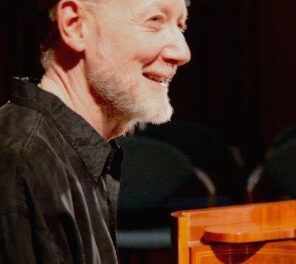Guest conductor Mei-Ann Chen and solo violinist Alexi Kenney headlined the Asheville Symphony‘s Masterworks 5 concert in Thomas Wolfe Auditorium with three beloved folk-influenced works. Zoltán Kodály’s Dances of Galánta (1933) and Antonín Dvořák’s Violin Concerto in A minor, Op. 53 (1880), formed the first half, and following intermission was Ludwig van Beethoven’s Symphony No. 6 in F, Op. 68 (Pastoral) (1808). The concert, sponsored by Mrs. And Mrs. Henry W. Kramer, was recorded for broadcast on March 19 and March 21 on Blue Ridge Public Radio.
Taiwanese-American conductor Chen was a congenial presence on the podium with her warm remarks to the audience and genuine rapport with the orchestra. She came to the U.S. in 1989 to study violin but expanded her studies to include conducting. She earned her doctorate in conducting from the University of Michigan and appears widely as a guest conductor. She was appointed conductor of the Chicago Sinfonietta in 2011. Among her many accolades has been the acknowledgment that she is an outstanding leader in her field, chosen in 2015 as one of the top 30 influencers by Musical America. Since 2016 she has served as artistic director and conductor for the National Taiwan Symphony Orchestra Summer Festival.
Kenney is one of America’s rising violin stars. A native of Palo Alto, California, the 25-year old completed his Bachelor of Music and Artist Diploma at the New England Conservatory of Music under the tutelage of Donald Weilerstein and Miriam Fried. In 2013, when only 19, he won the Concert Artists Guild Competition, which led to a debut recital at Carnegie Hall’s Weill Hall. He was the recipient of the 2016 Avery Fisher Career Grant, and he concertizes widely internationally as both a soloist and chamber music player.
The program’s opener, Kodály’s Dances of Galánta immediately put the orchestra through their paces. This lushly scored and exotic set of five dances arose from the street and café music of Galánta, a small town, now in Slovakia but then part of Hungary, when the composer lived there in his youth. Kodály paid tribute to the sophisticated Roma musicians of the region who, in the 18th century, played from written music in the orchestras of the nobility. While each dance was composed in a different mode and with different themes and rhythms, the whole was undergirded with an infectious rhythmic vitality and, occasionally, a blistering pace in tight-knit ensemble, ably conducted by Chen. There were outstanding solos among the winds, especially clarinet, flute, and oboe.
Dvořák’s Violin Concerto, heavily influenced by Brahms’ own concerto, was composed at the suggestion of Simrock, Brahms’ publisher, and the composer complied, hoping for assistance from Joseph Joachim, the great concert violinist. Because Joachim was deeply critical of the work, Dvořák completely revised it, completing it in 1882. This is a full-blown Romantic piece, requiring deep musicality and great stamina from the soloist.
The first two of the three concerto movements proceed without a break, requiring the artist to concentrate through this longer-than-usual trajectory. Other challenges are the sheer length of the passages the soloist must play, each packed with technical demands. Despite his youth, Kenney was clearly up to these challenges. He proved to be a commanding artist, technically sure, who was entirely at ease on the stage. He was able to execute the fiercest passagework with an astonishing economy of motion, especially savoring his many soloistic flourishes ending on extremely high notes (played perfectly in tune). He plays from the heart with deeply felt expressivity – rare in such a young musician. The orchestra accompanied him beautifully, matching him stylistically and mounting some gorgeous solo moments of its own (horns!).
Beethoven’s Pastoral Symphony worked well as the closing piece on this folk-inspired concert. The orchestra played this work with easy familiarity, like a conversation with an old friend. Chen chose just the right tempo for the first movement (“Awakening of cheerful feelings on arrival in the countryside”). Rather quiet at first, the piece blossomed well into the movement with radiant sounds of pure joy. The second movement (“Scene by the brook”) was lovely with its gentle oscillating figures, culminating in the three bird calls at movement’s end. The pace picked up with the lusty folk dance of movement three (“Merry gathering of country folk”) which featured comical interjecting solos from oboe, bassoon, clarinet, and horn. The interruption of the thunderstorm (movement four) was thrilling and appropriately unsettling, followed without pause by the restoration of order in movement five (“Shepherd’s song”), a melodious benediction on our time in the country. Kudos to the Asheville Symphony for such marvelous programming and playing!











